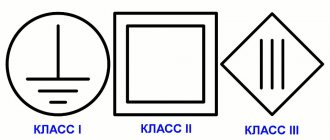Issues of electrical safety in production are only part of all activities and industrial safety requirements. Compliance with the requirements of numerous instructions and rules, ensuring safe working conditions is entrusted to the employer by the Labor Code of the Russian Federation. He is also responsible. Its extent depends on the severity of the consequences of violations or failure to comply with industrial safety and labor protection requirements. The head of an enterprise, especially if it is large, appoints employees responsible for compliance with occupational safety, fire and electrical safety requirements.
Regulations
The Rules for the Construction of Electrical Installations (PUE) apply to all electrical installations under construction and reconstruction of alternating and direct current with a voltage of 750 kV and are mandatory, regardless of industry affiliation and form of ownership. The new, 7th edition is constantly updated as materials are processed and agreed upon with interested departments and approved by the ministry.
Nevertheless, experts argue that the publication does not cover the entire scope of the necessary changes, and probably in the near future the next updated edition of the PUE will be published.
Labor protection and fire safety requirements when working with electrical installations are also changing.
Categories of premises for electrical safety, PUE
In accordance with the rules of design, an electrical installation is a set of technological electrical equipment of machines and devices, together with the structures in which they are installed, intended for generation or transmission, transformation and redistribution, conversion into other types of energy. Are divided into:
- External (open). Located in open areas not protected from weather influences.
- Closed (internal). Located in buildings that protect them from atmospheric influences.
Electrical rooms are various structures, buildings or fenced off parts of the premises in which electrical equipment is located with access only to qualified personnel engaged in maintenance. All these electrical safety premises are divided into 4 categories:
- Premises without increased danger.
- Premises with increased danger.
- Particularly dangerous.
- Territories where open electrical installations are installed, where people can be electrocuted, are considered particularly dangerous areas.
1 category
The PUE states that these are premises in which there are no conditions for increased or special danger. What kind of premises are these?
Premises without increased danger are ordinary residential or office buildings. Social enterprises: preschool institutions, schools, hospitals and so on. Basic requirements for category 1:
- Dry - 60% and wet rooms where air humidity should not exceed 75%.
- Working supply and exhaust ventilation. There should be no conductive dust or chemical compounds in the air.
- The ambient temperature does not exceed +35°C.
- The floor covering must be made of non-electrically conductive materials.
Some production facilities and workshops can also be included in this category, but the above conditions must be met. Occupational safety requirements for employees are limited to introductory briefings and on-the-job briefings twice a year.
Specialists with the 3rd tolerance group up to 1000 volts are allowed to service electrical installations. The person responsible for electrical equipment is appointed from the engineering staff with the 4th group.
Category 2: hazardous premises for electrical safety
The current classification of premises according to the electrical safety of the Electrical Installation Code (PUE) includes those that meet the following criteria in the second category:
- Damp rooms. Humidity more than 75%
- There may be conductive dust in the air.
- Workshops with high levels of chemical compounds in the air.
- The floors are made of materials capable of conducting electricity (metal, earth, reinforced concrete, brick, etc.).
- Rooms with high temperatures.
- The ability to simultaneously touch a machine or other equipment on one side and metal parts (cases) of electrical equipment or exposed conductive parts on the other.
The list of enterprises and workshops that fall into this category is very large. Almost all enterprises, with the exception of especially dangerous ones, fall into this category.
It is mandatory to carry out occupational health and safety measures. In specialties related to work in hazardous and hazardous industries, additional training is provided with certification and admission of workers. Certification of workplaces is carried out.
At enterprises, it is mandatory to carry out an electrical inspection of the premises for electrical safety. Based on the findings of the examination, a category is assigned and a special sign (plate) is posted at the entrance, which indicates the electrical safety class of the room.
Only qualified specialists who have undergone training and have a clearance group in accordance with labor protection requirements when servicing electrical installations are allowed to perform maintenance.
Category 3: especially dangerous premises for electrical safety
Particularly dangerous electrical safety premises include those in which there is at least one of the following factors:
- Particularly raw. Air humidity 100%. Walls and equipment become covered with moisture that falls in the form of condensation.
- Premises with an active chemical or organic environment that occurs in the room during the work shift. This environment destroys electrical installation parts and wire insulation.
- If two factors related to high-risk conditions occur simultaneously.
This category of electrical safety premises has special requirements for the equipment and materials used. More frequent maintenance and repairs are provided. Only qualified personnel trained to work in certain conditions work. Labor protection, as a rule, classifies such production as hazardous.
Category 4: territories where open electrical installations are installed
The category of especially dangerous includes outdoor switchgear - open switchgear. Transformer substations, distribution centers consisting of a huge amount of electrical equipment. Located in an open area and surrounded by a fence. These are areas closed to unauthorized entry, where special industry requirements for labor protection and worker qualifications apply.
All premises certified for electrical safety must be marked with signs informing workers and representatives of regulatory authorities about the category of danger behind the doors.
Types of electrical installations according to electrical safety conditions
According to the electrical safety parameter, all installations are divided into 4 main types:
- Electrical installations with a voltage rating above 1 kV in networks with high ground fault currents (i.e. with an effectively grounded neutral);
Electrical installations with voltages above 1 kV are widely used in a wide variety of areas
Devices for grounding such installations are made with strict adherence to strict requirements for resistance, voltage, design features, as well as voltage limitation directly on the grounding mechanism itself. When current flows from the grounding device to the ground, the voltage should not exceed 10 kV.
Voltages exceeding 10 kV are permissible only on those grounding conductors from which the transfer of potentials beyond the fence of the electrical installation is completely excluded. If the voltage on the grounding devices varies in the range from 5 to 10 kV, the design must provide additional protection for the insulation of outgoing cables, as well as telemechanics.
The resistance inside the grounding device should under no circumstances exceed 0.5 ohms.
Longitudinal type grounding conductors must be laid at a depth of 0.5-0.7 meters, at a distance of about a meter from the bases of buildings and equipment along the axes of the installations.
As for the transverse earthing conductors, they should be placed in any suitable places between the equipment. The laying depth can vary from 0.5 to 0.7 meters.
Experts recommend laying horizontal grounding conductors along the very edge of the territory they occupy. Moreover, in such a way that at the end of the work a completely closed circuit is obtained.
You cannot connect the external fencing of an electrical device to the grounding device in any way. If high-voltage power lines of 100 kV and higher (lightning cables) extend from the equipment, the fence should be grounded using vertical ground electrodes no less than 2 meters long. They must be installed at fence posts (along the perimeter) at intervals of 20 to 50 m. Installation of such a grounding system is not required if the electrical equipment fence is equipped with posts made of metal or reinforced concrete. The fittings of the latter must necessarily be connected to the metal sections of the fence.
In order to completely eliminate the occurrence of electrical communication between the external fence and the ground electrode, the distance from one to the other must be more than 2 meters. At the same time, all those elements (horizontal grounding conductors, cables, wires, pipes, etc.) that are laid between the fence posts must be deep enough - more than half a meter. In those areas where the external fence is adjacent to buildings, it is necessary to provide special wooden or brick spacers longer than 1 meter.
If the earth electrode of electrical equipment is connected to the earth electrode of an electrical installation above 1 kV with a neutral-earthed metal-sheathed cable, strict compliance with one of the following conditions will be required to equalize the potentials:
- Mandatory laying of a grounding device to a depth of at least one meter and at a distance of at least one meter from the foundation of the building (the perimeter of the territory occupied by the equipment), which would be connected to metal structures and the grounding network, and at the entrances and driveways - laying of conductors to a depth of 1.5 m at a distance of 2 m from the ground electrode. These grounding electrodes must be connected by a conductor;
- The use of reinforced concrete foundations as an alternative to grounding devices. It is important to take into account the proper provision of an appropriate level of potential equalization.
The above conditions will not be required if there are asphalt blind areas around the building or structure. If they are still missing at any of the outputs or exits, you will need to perform potential equalization using the already described procedure for laying two conductors.
- Electrical installations above 1 kV in networks with an isolated neutral (low ground fault currents);
The answer to the question of electrical safety of such installations lies primarily in the fact that the resistance of the ground electrode, regardless of weather and external factors, when the calculated ground fault current passes, should not be higher than 10 Ohms. The rated current is understood as the total ground fault current.
Electrical substations clearly demonstrate how a network with an isolated neutral should be organized in this case
An insulated neutral makes it possible to use electrical equipment in conditions that require the use of increased requirements for electrical safety parameters, with strict control over the condition and integrity of the insulating layer, as well as all safety elements.
Networks with voltages above 1 kV with an insulated neutral include networks in which the voltage varies from 3 to 33 kV. If we are looking for an answer to the safety question, in this case capacitive conductivity should not be neglected under any circumstances.
In standard mode, the currents in each of the source phases are calculated by the geometric sum of the loads and the capacitive currents of the phases with respect to ground. It should be remembered that the geometric sum of the capacitive currents of all three phases is zero, therefore the current does not pass in the ground.
The use of a three-phase network with a voltage from 3 to 35 kV with an insulated neutral is connected not so much with electrical safety requirements (moreover, they always pose a serious danger to human life and health), but rather with ensuring the normal operation of electrical equipment connected to phase-to-phase voltage. The fact is that in the case of a single-phase ground fault in such networks equipped with an insulated neutral, the phase-to-phase voltages remain the same in magnitude and are shifted by an angle of 120 degrees in phase.
Increasing the voltage to a linear value normally applies to the entire network. This means that if this situation persists for a long time, damage to the insulating material will inevitably follow. The latter will result in a phase-to-phase short circuit.
There is probably no universal answer to the question of how to avoid such short circuits. But certain measures in the direction of quickly finding ground faults must be thought out in advance. To do this, automatic control of the network insulation must be performed, which would act on the signal in cases where the insulation resistance of any of the phases decreases below the specified value.
In networks that are responsible for providing power to substations in coal mines, peat mines, mobile installations and other similar equipment, the fault protection system must operate to shut down.
- Electrical installations with voltage up to 1 kV with solid neutral grounding;
The answer to the question of what should be the resistance of grounding devices in installations in which the voltage does not exceed 1 kW is quite specific: no more than 4 Ohms. But traditionally there are some exceptions. We are talking about electrical equipment in which the total power of the transformers and generators installed on it does not exceed 100 kVA. In such cases, the resistance can reach 10 ohms.
A simple example of grounding a generator with a solidly grounded neutral looks something like this
Those parts of electrical installations that require grounding must be connected via metal conductors to the neutral of the power source. It is also possible to use a neutral wire.
When it comes to overhead lines, a metallic connection to the neutral can also be provided by means of a neutral wire. It is laid on supports by analogy with phase cables. For every 250 meters, as well as at the end points and branches of the line, there must be repeated grounding of the neutral wire. The resistance of grounding conductors at repeated grounding points should be no more than 10 Ohms.
The solidly grounded neutral provides reliable protection for humans against electric shock. In the event of an accident, the potentials are equalized, and touching the body of the electrical equipment remains completely safe - the protective shutdown device is triggered.
- Electrical installations with voltage up to 1 kV with insulated neutral.
In electrical equipment with voltage up to 1 kV, the resistance should not be higher than 4 ohms. If we are talking about installations in which the total power of all operating generators and transformers is 100 kVA, it should not exceed 10 Ohms, as is the case with solid grounding.
An isolated neutral is one that is not connected to a grounding device. Or it can be connected using special equipment that compensates for the capacitive current in the network, or devices with a high resistance value. Grounding the neutral of a transformer or generator is called working grounding (not to be confused with protective grounding).
The resistance in the grounding device to which the neutrals of transformers and generators are connected should be no more than 4 Ohms for electrical equipment with a voltage of 220/380V.
In equipment with an isolated neutral, breakdown fuses are usually installed at the neutral terminals of transformers. They reliably contain the possibility of electric shock, which inevitably arises in the event of damage to the insulating layer between the low and high voltage windings.
A breakout fuse is a kind of cartridge made of porcelain, equipped with two copper plates with a mica gasket with small holes. One plate is connected to the neutral terminal of the transformer, and the other - directly to the main ground bus. In situations of insulation damage between the voltage windings of the transformer, a potential transition occurs from the higher voltage winding to the lower voltage winding. When the voltage at the neutral terminal increases above 500 V, the air gap in the breakout fuse gasket breaks through, and the dangerous potential goes into the ground.
This is what a blowout fuse looks like
Having considered all four types of electrical installations in terms of electrical safety conditions and their specifics, the principle of safe work with such equipment becomes more clear.










